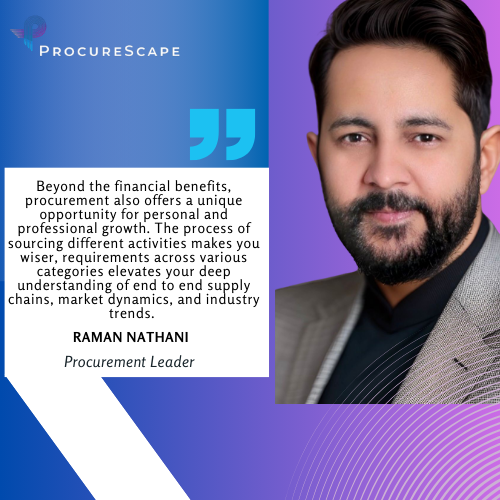Raman Nathani can be classified as a seasoned Strategic Procurement Director with over 20 years of experience. His expertise encompasses a wide range of areas including spend analysis, profit centre creation, and supplier relationship management. A proven track record of leading procurement operations for major projects across various industries in the Middle East, working with notable companies such as Red Sea Global and Abu Dhabi Airport Company his commitment to driving cost optimisation, fostering strategic partnerships, and mentoring Emirati nationals showcases his leadership skills and dedication to business excellence.
What has 20 years experience taught him, have procurement perceptions changed, what does the future hold? Raman offers insights into this and more. Over to Raman.
Procurement: A Catalyst for Business Growth and Personal Development
One of the best things that I find the most rewarding aspect of procurement is its potential to significantly impact a business’s bottom line. By fostering relationships with innovative suppliers and implementing strategic sourcing solutions, we not only drive cost savings but also enhance operational efficiency, and ultimately deliver greater value to our customers.
Beyond the financial benefits, procurement also offers a unique opportunity for personal and professional growth. The process of sourcing different activities makes you wiser, requirements across various categories elevates your deep understanding of end to end supply chains, market dynamics, and industry trends. This exposure to a wide range of products and services significantly enhances our intellectual capacity and contribute to a more informed and strategic approach to decision-making in day to day life.
Like many of my other peers, my journey into procurement was also landed accidently. Beginning in sales and finance, I transitioned into procurement, supporting various industries including manufacturing, Aviation, entertainment, Construction and Healthcare. My experiences across these diverse industries have equipped me with a broad range of roles, from business analyst and category management to transformation leadership.
While the perception of procurement has evolved over time across including mine over the years, I’ve come to appreciate its transformative potential only in last 7 years, procurement has rightfully earned its strategic place within organizations. Nevertheless, I believe there’s still room for further advancement and recognition of its value.
The Evolving Landscape of Procurement
Historically, procurement has often been relegated to administrative tasks, responding reactively to purchase requests. However, the global recession of 2008 marked a turning point, as procurement emerged from its transactional role to become a more strategic and cost-driven function. The introduction of category management and strategic sourcing elevated procurement to the C-suite, transforming it from a mere purchasing department.
Spend analysis and data-driven decision-making became integral components of the procurement function. Despite these advancements, there remains a misconception that procurement is solely focused on cost savings, a fixation that can sometimes overshadow broader strategic objectives. The recession of 2008, while challenging, provided an opportunity for procurement to demonstrate its value, as global price decreases facilitated cost reduction efforts.
The COVID-19 pandemic further reshaped the procurement landscape, highlighting the importance of agility, supply chain resilience, and risk mitigation. Lessons learned during this period include the need for consolidation, hybrid approaches, and strategic supplier relationships. Beyond cost reduction, procurement must now prioritize securing supply chains and adapting to rapidly changing market conditions.
So Priorities and approach have changed for CPO in every 5 years I see. While digital transformation has significantly improved procurement efficiency over the past decade, challenges still persist in implementing comprehensive end-to-end digital solutions that meet the needs of all stakeholders, including procurement professionals, end-users, suppliers, and stakeholders.
Room for Improvement
There are many things procurement can do better in my view, latest in my focus these days is Leveraging Expanded Reality for Enhanced Procurement. For instance, Conduct virtual tours of supplier facilities, enabling more efficient evaluation and selection, Utilize AI/AR to analyze and visualize procurement data.
However, beyond technological advancements, procurement must also address broader strategic challenges specially to make its right place including:
- Strategic Alignment
- Deeper Business Understanding
- Fair Procurement Processes
- Technology Adoption
- Talent Development
- Agility
- Sustainability
This has always been a setback that despite its significant contributions, procurement often faces challenges in gaining the recognition it deserves. Many CEOs, from small businesses to multinational corporations, prioritize other functions over procurement. To address this perception gap, procurement leaders must actively showcase the value that procurement brings to the organization, One of the key that procurement should emphasize and address is diversity in team. By fostering a diverse workforce, organizations can not only benefit unique ideas, new approach and creativity within their performance but also it creates a position and strategic perspectives.
Key Points to Emphasize:
- The strategic importance of procurement.
- Expanded Reality for Enhanced Procurement
- The need for broader strategic improvements.
- The importance of perception change.

